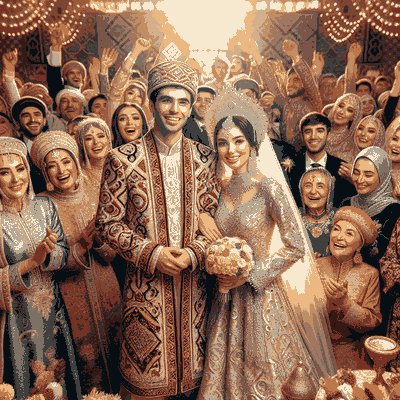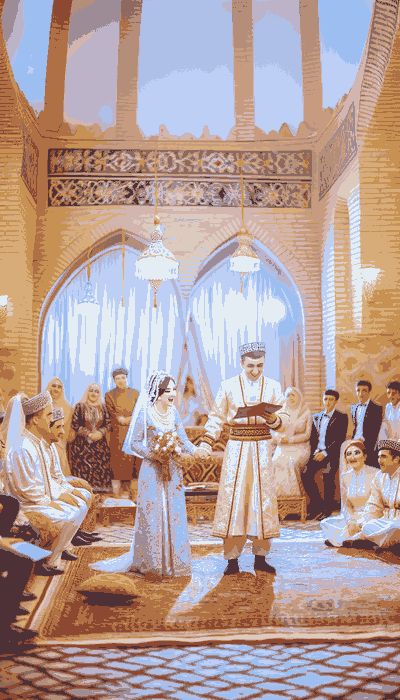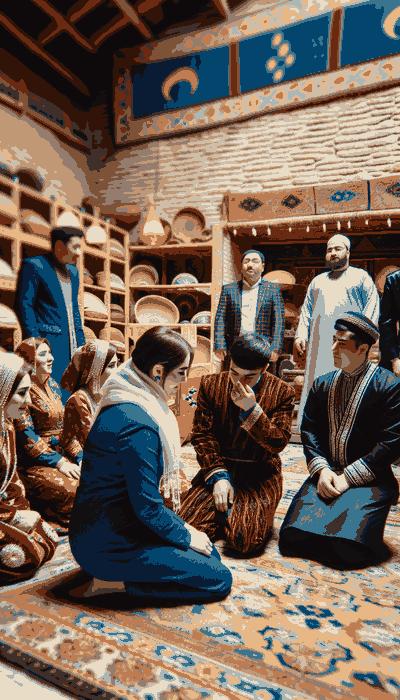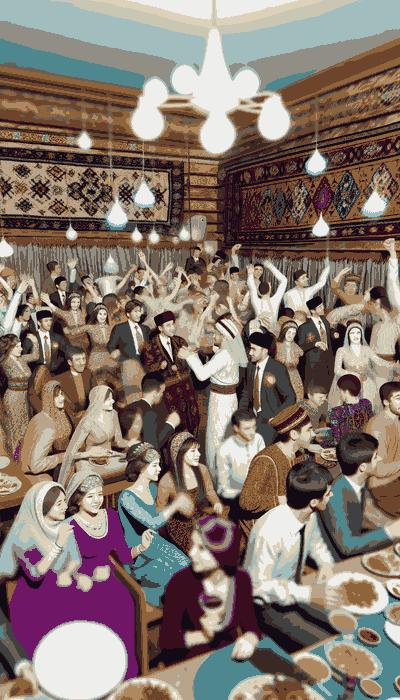Uzbekistan Wedding Traditions
Uzbekistan wedding traditions are elaborate multi-day celebrations combining Islamic religious ceremonies, pre-Soviet cultural customs, and modern influences that typically involve 200-500 guests and can cost $5,000-$30,000 USD. These traditions encompass pre-wedding matchmaking (Sovchiliksov-CHEE-lik), engagement ceremonies (Fotikha-Tuifoh-tee-KHA too-EE), religious marriage (Nikokh-Tuinee-KOKH too-EE), elaborate feasting with morning pilaf, and post-wedding rituals, creating celebrations that last 1-3 days in urban areas or up to a week in traditional rural communities.

Key Components of Uzbek Wedding Celebrations

- Duration: 1-3 days (urban) to 7 days (traditional rural)
- Guest Count: 150-500 people (average 250-300)
- Total Cost: $5,000-$30,000 USD depending on scale and region
- Key Ceremonies: Sovchiliksov-CHEE-likmatchmaking, Fotikha-Tuifoh-tee-KHA too-EEengagement, Nikokh-Tuinee-KOKH too-EEreligious ceremony, Morning Pilaf feast
- Regional Variations: Tashkent (modern), Bukhara (golden textiles), Samarkand (elaborate feasts), Fergana Valley (most traditional)
- Required Elements: Civil registration at ZAGSzahks, Islamic Nikokh ceremony, family gift exchanges
Pre-Wedding Traditions and Ceremonies

What is Sovchilik (Traditional Matchmaking)?
Sovchiliksov-CHEE-lik is the formal matchmaking process where the groom’s female relatives visit potential brides’ homes to assess compatibility and family reputation, dating back centuries when marriages strengthened family alliances. This tradition involves 2-5 visits over 1-3 months before formally requesting the bride’s hand in marriage.
Modern Sovchilik Practice (2025):
- Urban areas: 65% of couples meet independently but still observe formal matchmaking
- Rural regions: 80% follow traditional arranged introductions
- Process duration: 1-3 months of family visits
- Participants: Mother, aunts, and elder female relatives of the groom
- Success rate: 70% of formal proposals are accepted after matchmaking
In Bukhara, known as Uzbekistan’s most modernized wedding region after Tashkent, young professionals increasingly find partners through work or education, though family approval through Sovchilik remains essential for 95% of marriages.
Fotikha-Tui (Engagement Ceremony) Details
Fotikha-Tuifoh-tee-KHA too-EE is the official engagement ceremony named after the Quran’s first surah, marking the families’ formal agreement to unite through marriage with 50-200 guests present. This ceremony centers on the Non Sindirishnon sin-dee-RISH (bread breaking) ritual where family elders break traditional round bread to seal their commitment.
Engagement Ceremony Components:
- Timing: 3-12 months before wedding
- Guest count: 50-200 people
- Cost: $500-$2,000 USD
- Duration: 3-5 hours
- Key ritual: Non Sindirish (bread breaking)
- Gifts exchanged: Gold jewelry ($500-$5,000), traditional sweets, fruits
Regional Fotikha-Tui Variations:
- Tashkent: Simplified 2-3 hour ceremonies in restaurants
- Fergana Valley: Traditional home celebrations with 150+ guests
- Samarkand: Elaborate gift presentations including livestock
- Bukhara: Focus on gold jewelry and textile gifts
Sarpo (Wedding Clothes and Gift Preparation)
Sarposar-POH is the traditional presentation of wedding attire and household items from the groom’s family to the bride, typically including 5-15 complete outfits, gold jewelry, and household essentials worth $1,000-$10,000 USD. This tradition demonstrates the groom’s family’s ability to provide for the bride and occurs 1-3 months before the wedding.
Modern Sarpo Contents:
- Clothing: 5-15 complete outfits including traditional and modern styles
- Jewelry: Gold sets worth $500-$5,000
- Textiles: 10-20 pieces of fabric for future clothing
- Household items: Bedding, kitchen essentials, decorative items
- Cosmetics and accessories: Modern additions to traditional gifts
Regional Sarpo Distinctions:
- Bukhara: Famous golden embroidered suits worth $1,000-$3,000 each
- Fergana Valley: Emphasis on handwoven atlasaht-LAHS silk fabrics
- Tashkent: Mix of traditional textiles and modern designer clothing
- Rural areas: Greater focus on practical household items
Main Wedding Ceremonies

Civil Registration at ZAGS (Legal Requirements)
Civil registration at ZAGSzahksZapis Aktov Grazhdanskogo Sostoyaniya is the mandatory legal marriage procedure required since Soviet times, costing 100,000-200,000 UZS ($8-16 USD) and taking 30-60 minutes. All couples must complete this registration for legal recognition, regardless of religious ceremonies.
ZAGS Registration Process:
- Required documents: Passports, birth certificates, single status certificates
- Processing time: Same-day to 1 month depending on documentation
- Cost: 100,000-200,000 UZS ($8-16 USD)
- Popular days: Fridays and Saturdays
- Photography: Professional sessions at monuments after registration
Modern ZAGS Practices: Urban couples increasingly make the civil registration festive with professional photography at Tashkent’s Independence Square or Samarkand’s Registan, while rural couples often complete registration quietly before the main celebration.
Nikokh-Tui (Islamic Religious Ceremony)
Nikokh-Tuinee-KOKH too-EE is the Islamic marriage ceremony conducted by an imam where the couple exchanges vows according to Sharia law, considered more spiritually significant than civil registration by 90% of Uzbek families. This 30-60 minute ceremony requires two male witnesses and includes Quranic recitations, marriage contract signing, and guidance on Islamic marital duties.
Nikokh Ceremony Structure:
- Duration: 30-60 minutes
- Participants: Imam, couple (often in separate rooms), 2 male witnesses
- Cost: Imam fee 500,000-2,000,000 UZS ($40-160 USD)
- Location: Home (60%), mosque (25%), wedding venue (15%)
- Key elements: Consent verification, Quran recitation, dua (prayers)
Regional Nikokh Variations:
- Traditional regions: Bride and groom in separate rooms (70% of ceremonies)
- Urban areas: Couple increasingly in same room (40% in Tashkent)
- Fergana Valley: Strictest separation protocols maintained
- Bukhara: Often includes additional Sufi blessing traditions
Kelin Salom (Bride’s Greeting Ceremony)
Kelin Salomkeh-LEEN sah-LOM is the traditional ceremony where the bride greets her new family with deep bows while wearing elaborate traditional attire, symbolizing respect and integration into the groom’s household. This emotionally significant ritual takes 30-90 minutes and occurs on the wedding day or within three days after.
Kelin Salom Components:
- Timing: Wedding day or within 3 days
- Duration: 30-90 minutes
- Participants: All wedding guests (150-500 people)
- Bride’s attire: Traditional costume worth $500-$3,000
- Key action: Deep bows every 3-5 steps
Regional Kelin Salom Traditions:
- Bukhara: Heavy gold-embroidered robes weighing 5-10 kg
- Tashkent: Coin throwing by guests for prosperity
- Khorezm: Accompanied by specific regional music
- Samarkand: Additional gift presentation during bows
Wedding Day Celebrations
Morning Pilaf (Traditional Wedding Feast)
Morning Pilaf (Oshosh) is the essential wedding feast where specialized male chefs prepare Uzbekistan’s national dish in 50-200 liter cauldrons to serve 200-1,000 guests, symbolizing abundance and community unity. This tradition begins at 5-6 AM with preparation and serves guests from 6-9 AM, costing $500-$3,000 depending on guest count.
Morning Pilaf Statistics:
- Preparation time: 3-4 hours (starting 5 AM)
- Serving time: 6-9 AM
- Guest capacity: 200-1,000 people
- Rice quantity: 50-200 kg per wedding
- Cost: $2-5 per guest
- Chef (Oshpazosh-PAHZ) fee: $200-$1,000
Regional Pilaf Variations:
- Fergana style: Yellow color from carrots, distinct cumin flavor
- Samarkand style: Darker rice from extended frying, richer taste
- Tashkent style: Includes chickpeas and extra garlic
- Bukhara style: Contains dried fruits and special spice blend
Wedding Procession Traditions
The wedding procession (Kelin Keltirishkeh-LEEN kel-tee-RISH) traditionally announces the bride’s journey from her family home to the groom’s residence with musicians playing karnaykar-NAI and surnaysur-NAI instruments. Modern processions use 5-20 decorated cars traveling through city landmarks, costing $200-$1,000 for vehicles and decorations.
Procession Elements:
- Traditional: Musicians, walking participants, 2-3 hours
- Modern: 5-20 decorated cars, 1-2 hour city tour
- Music: Live karnay/surnay ($200-$500) or recorded
- Route: Monuments, photo stops, 10-30 km distance
- Participants: 20-100 people in procession
Evening Reception and Entertainment
Evening wedding receptions feature 4-8 hours of celebration with professional musicians, dancers, and elaborate multi-course meals for 150-500 guests, costing $3,000-$20,000. These celebrations combine traditional performances with modern entertainment.
Reception Components:
- Duration: 4-8 hours (6 PM - 2 AM)
- Entertainment budget: $1,000-$5,000
- Meal courses: 8-15 different dishes
- Dance performances: 3-5 professional acts
- Music: Traditional ensemble + modern DJ/band
Modern Entertainment Trends:
- Tashkent: LED screens, projection mapping, international DJs
- Traditional regions: Focus on live traditional music
- Fusion approach: 60% traditional, 40% modern music
- Interactive elements: Guest participation dances increasing
Post-Wedding Traditions
Kelin Kuchdi (Bride’s Official Move)
Kelin Kuchdikeh-LEEN kooch-DEE marks the bride’s formal transition to her new household 1-7 days after the wedding, involving ceremonial moving of her belongings and special preparations of her living quarters. This tradition remains significant even for couples establishing independent homes.
Transition Process:
- Traditional: Bride moves to groom’s family home (40% rural, 10% urban)
- Modern: Symbolic visit before moving to separate residence (60% urban)
- Duration: 1-3 days of integration activities
- Key rituals: Special room preparation, blessing ceremonies
Chilla (Forty Days Period)
Chillachil-LAH represents the first forty days of marriage considered a spiritually significant adjustment period requiring special care and limited social activities. This protective tradition derives from Islamic and Central Asian beliefs about transformation cycles.
Chilla Observances:
- Traditional restrictions: Limited travel, avoiding crowds
- Modern adaptations: Symbolic recognition with special meal at 40 days
- Regional differences: Strictly observed in 60% of rural families, 20% urban
- Completion celebration: Family gathering with special foods
Regional Wedding Variations Across Uzbekistan
Tashkent Wedding Traditions
Tashkent weddings represent Uzbekistan’s most modernized celebrations, blending Western influences with core traditions, featuring 150-300 guests and costing $5,000-$30,000. These urban celebrations incorporate professional planning, sophisticated venues, and international trends while maintaining essential ceremonies.
Tashkent Distinctive Features:
- Western elements: White gowns (70%), tiered cakes, photo booths
- Venue preferences: Modern banquet halls (60%), restaurants (30%)
- Planning approach: Professional planners used by 40% of couples
- Budget range: $5,000-$30,000 (highest in country)
- Guest count: 150-300 (smaller than traditional)
Bukhara’s Golden Wedding Traditions
Bukhara weddings feature distinctive gold-embroidered textiles worth $1,000-$5,000 per outfit, reflecting the city’s historical importance as a Silk Road trading center. These celebrations emphasize artistic heritage while embracing selective modernization.
Bukhara Specialties:
- Golden embroidery: Zardozizar-DOH-zee work on velvet ($1,000-$3,000 per piece)
- Suzanisoo-ZAH-nee textiles: Hand-embroidered pieces taking 6-12 months to create
- Musical traditions: Classical maqommah-KOHM performances unique to region
- Average cost: $8,000-$20,000 for complete celebration
Fergana Valley Traditional Celebrations
Fergana Valley maintains Uzbekistan’s most traditional wedding customs, with 70% of ceremonies following historical protocols, 300-500 guests, and multi-day celebrations. This region preserves ancient rituals while slowly incorporating modern elements.
Fergana Valley Characteristics:
- Atlasaht-LAHS silk: Locally woven ikatee-KAHT fabrics in every ceremony
- Duration: 3-7 days of continuous celebrations
- Guest count: 300-500 (highest average in country)
- Traditional adherence: 70% follow complete historical protocols
- Craft involvement: Local artisans create custom wedding items
Samarkand’s Historical Wedding Customs
Samarkand weddings emphasize elaborate feasting and historical venues, with ceremonies often held near UNESCO World Heritage sites and featuring the region’s famous pilaf variations. These celebrations balance tourist appeal with authentic traditions.
Samarkand Distinctions:
- Venue choices: Historical madrasas, traditional houses (havlihahv-LEE)
- Pilaf tradition: Most elaborate preparation methods
- Guest capacity: 200-400 people average
- Tourism integration: 15% include international guests
- Photography focus: Registan Square wedding shoots
Modern Adaptations and 2025 Trends
Technology in Uzbek Weddings
Digital transformation has revolutionized Uzbek wedding planning, with 80% of urban couples using Instagram for inspiration, 60% livestreaming ceremonies for distant relatives, and 40% sending digital invitations alongside traditional ones.
Digital Integration Statistics:
- Social media planning: 80% use Instagram/Pinterest
- Livestreaming: 60% broadcast to diaspora relatives
- Digital invitations: 40% use QR codes with traditional cards
- Hashtag creation: 70% create unique wedding hashtags
- Online registries: 20% in Tashkent (growing trend)
COVID-19 Impact and Recovery
The pandemic transformed Uzbek wedding practices, reducing average guest counts from 300 to 150 during 2020-2021, accelerating digital adoption, and creating new hybrid celebration models that persist in 2025. Lasting Changes from Pandemic:
- Hybrid ceremonies: 30% combine in-person and virtual elements
- Smaller celebrations: “Micro-weddings” of 50-100 guests gaining acceptance
- Outdoor venues: 25% increase in garden/outdoor celebrations
- Health protocols: Hand sanitizer stations now standard
- Flexible planning: Postponement insurance increasingly common
Fusion and International Influences
Contemporary Uzbek weddings increasingly blend traditions, with 45% of urban celebrations incorporating Western elements like first dances, 30% featuring international cuisine alongside traditional dishes, and 20% hiring both traditional ensembles and modern DJs.
Fusion Elements in 2025:
- Attire: Traditional costume for Nikokh, Western dress for reception (60%)
- Music: 60% traditional, 40% international mix
- Food: International desserts supplementing traditional sweets
- Photography: Drone footage and cinematographic videos standard
- Decor: Modern minimalism meeting traditional textiles
Wedding Costs and Financial Planning
Average Wedding Budgets by Region
Uzbek wedding costs vary significantly by region, ranging from $3,000 in rural areas to $30,000+ for elaborate Tashkent celebrations, with families typically saving 2-5 years or combining resources to fund these important social investments.
Regional Cost Breakdown:
- Tashkent: $10,000-$30,000 (average $15,000)
- Bukhara/Samarkand: $8,000-$20,000 (average $12,000)
- Regional centers: $5,000-$15,000 (average $8,000)
- Rural areas: $3,000-$10,000 (average $5,000)
Major Expense Categories:
- Venue and catering: 40-50% of budget
- Attire and jewelry: 20-30%
- Entertainment: 10-15%
- Photography/videography: 5-10%
- Decorations and flowers: 5-10%
Financial Strategies and Support Systems
Traditional cost-sharing systems persist, with the groom’s family covering 60-70% of expenses, community contributions through “gapgahp” (social groups) providing $1,000-$5,000 in support, and modern couples increasingly contributing their own savings.
Financial Support Methods:
- Family savings: 2-5 years of preparation typical
- Gap contributions: Community groups contribute $1,000-$5,000
- Wedding loans: 20% of families use formal/informal credit
- Diaspora support: Relatives abroad contribute to 30% of weddings
- Government programs: Some regions offer marriage support funds
Frequently Observed Wedding Traditions (Ranked by Popularity)
Most Common Traditions in 2025
Based on recent surveys and observations, these traditions remain nearly universal across all regions and social groups:
- Nikokh Ceremony: 98% of all Uzbek weddings
- Morning Pilaf: 95% maintain this tradition
- Non Sindirishnon sin-dee-RISH: 93% include bread-breaking at engagement
- Family Gift Exchange: 90% follow traditional protocols
- Kelin Salomkeh-LEEN sah-LOM: 85% include bride’s greeting ceremony
- Traditional Music: 85% feature live traditional instruments
- Multiple Costumes: 80% include outfit changes
- Honey Ritual: 75% perform this sweetness ceremony
- Professional Dancing: 70% hire traditional dancers
- Suzanisoo-ZAH-nee Display: 65% incorporate traditional textiles
Declining or Evolving Traditions
Some traditions are practiced less frequently or in modified forms:
- Chillachil-LAH40 days: Strictly observed by only 30% (60% symbolic recognition)
- Bet Ochaarbet oh-CHAR: Face unveiling ceremony practiced by 40%
- Multi-day celebrations: Only 25% have 3+ day weddings
- Complete traditional attire: 45% wear full traditional costume throughout
- Walking processions: 15% in urban areas (replaced by car processions)
Cultural Tourism and Destination Weddings
Uzbekistan as a Wedding Destination
Uzbekistan’s historical cities attract destination weddings, with Samarkand, Bukhara, and Khiva hosting 200+ international ceremonies annually, offering packages from $5,000-$50,000 combining cultural authenticity with luxury amenities.
Destination Wedding Offerings:
- Historic venues: Madrasas, traditional houses, silk road caravanserais
- Cultural packages: Traditional ceremonies with English translation
- Photography opportunities: UNESCO sites, architectural backgrounds
- All-inclusive services: Planning, catering, entertainment, accommodation
- Legal facilitation: Assistance with marriage documentation
Popular Destination Packages:
- Bukhara Heritage: 3-day celebration in historic settings ($10,000-$30,000)
- Samarkand Silk Road: Ceremonies at Registan complex ($15,000-$40,000)
- Desert Romance: Exclusive desert camp celebrations ($20,000-$50,000)
- Cultural Immersion: Full traditional experience with local families ($5,000-$15,000)
International Uzbek Wedding Services
Global cities now offer Uzbek wedding services, with specialized packages in Dubai, Istanbul, Moscow, and even Las Vegas catering to diaspora communities and cultural enthusiasts, adapting traditions to international settings.
Las Vegas Uzbek Packages: Several Las Vegas chapels now offer “Silk Road Romance” packages featuring:
- Suzanisoo-ZAH-nee decorations: Traditional textiles in chapel decor
- Pilaf catering: Authentic Uzbek cuisine options
- Musical fusion: Traditional instruments with Vegas entertainment
- Photography: Combining neon lights with traditional elements
- Price range: $2,000-$10,000 for complete packages
Preserving Traditions in the Modern Era
Cultural Heritage Initiatives
Government and cultural organizations actively preserve wedding traditions through documentation projects, artisan support programs, and educational initiatives ensuring transmission to younger generations while allowing natural evolution.
Preservation Efforts:
- UNESCO recognition: Traditional music and textiles protected
- Artisan programs: Supporting wedding craft specialists
- Documentation: Recording regional variations and oral histories
- Education: School programs teaching traditional customs
- Tourism integration: Authentic cultural experiences for visitors
Balancing Tradition and Modernity
Contemporary Uzbek couples navigate tradition and modernity by maintaining core religious and family ceremonies while adapting timelines, guest lists, and celebration styles to fit modern lifestyles and budgets.
Common Balanced Approaches:
- Essential traditions maintained: Nikokh, pilaf, family ceremonies
- Modified elements: Shortened timelines, smaller guest lists
- Modern additions: Professional planning, digital elements
- Cultural pride: Young couples rediscovering traditional crafts
- Flexible interpretation: Adapting customs to contemporary values
Conclusion: The Future of Uzbek Wedding Traditions
Uzbek wedding traditions in 2025 demonstrate remarkable resilience and adaptability, maintaining essential cultural and religious elements while embracing practical modernizations. From the mountains of Fergana to the boulevards of Tashkent, these celebrations continue to strengthen family bonds, preserve cultural heritage and create memorable experiences that honor the past while embracing the future. As Uzbekistan’s younger generation balances global influences with cultural pride, wedding traditions evolve to remain relevant while preserving their essential character as community celebrations of love, family, and cultural identity.
Frequently Asked Questions
How long does a traditional Uzbek wedding celebration last?
Traditional Uzbek weddings typically last 1-7 days, with most modern celebrations spanning 2-3 days of ceremonies and festivities.
What is Sovchilik in Uzbek wedding traditions?
Sovchilik is the formal matchmaking process where the groom's female relatives visit the bride's family to negotiate marriage arrangements, lasting 1-3 months.
How much does an Uzbek wedding typically cost?
Uzbek weddings typically cost between $5,000-$30,000, with average celebrations ranging from $5,000-$15,000 depending on the region and scale.
What is the Kelin Salom ceremony?
Kelin Salom is a formal greeting ceremony where the bride shows respect to her new family through traditional bows and receives gifts in return.
Are Uzbek weddings religious ceremonies?
Uzbek weddings combine both civil (ZAGS) and religious (Nikokh-Tui) ceremonies, reflecting the nation's Islamic heritage and legal requirements.
What is the significance of the morning pilaf?
The morning pilaf is an essential wedding feast prepared by specialized chefs, symbolizing hospitality and community celebration.
How are modern elements incorporated into traditional Uzbek weddings?
Modern Uzbek weddings often include social media sharing, livestreaming, digital invitations, and Western elements while maintaining core traditions.
What is the Chilla period?
Chilla is a 40-day post-wedding adjustment period where the newlyweds adapt to married life under traditional customs and guidance.
How do wedding traditions vary across Uzbekistan?
Wedding traditions vary by region: Tashkent features modern elements, Bukhara emphasizes traditional textiles, and Fergana Valley maintains the most traditional customs.
Who typically pays for an Uzbek wedding?
The groom's family traditionally covers 60-70% of wedding costs, with additional funding from community contributions and personal savings.